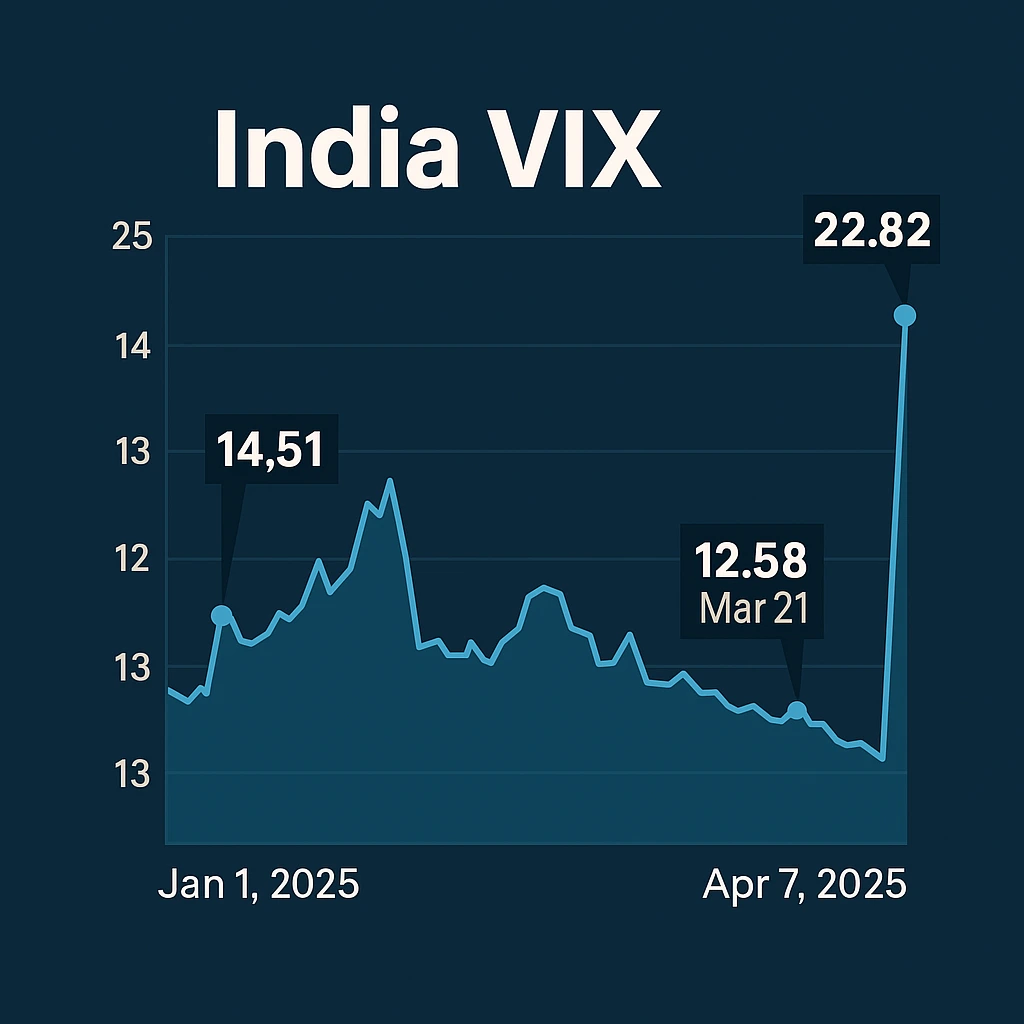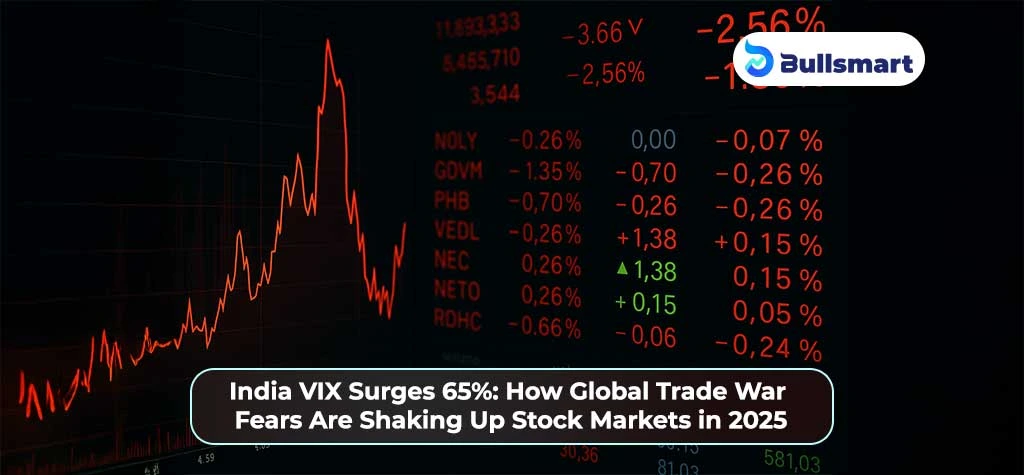On April 7, 2025, India’s stock markets witnessed a major shock. The India VIX, also known as the volatility index or the fear gauge, spiked by nearly 65% in a single day — one of the highest single-day jumps in recent years. This sudden rise shows that investors are feeling nervous about what lies ahead for the markets.
The main reason behind this panic is the growing fear of a global trade war. The United States, under President Donald Trump, announced steep tariffs on several imports from Asia and Europe. China quickly responded with its own set of trade restrictions. This back-and-forth has made investors worldwide uneasy, with many worried about a possible recession in the U.S. and its impact on the global economy.
Back home, the effect was immediate. The Sensex fell over 3,900 points, and the Nifty dropped below the 22,000 mark, with heavy selling across all sectors.
In this blog, we’ll explain what the India VIX is, why it rose so sharply, how global events are affecting our markets, and what steps investors should consider during such volatile times.
What is India VIX? Understanding the Market’s Fear Gauge
The India VIX, or India Volatility Index, is often called the “fear gauge” of the stock market. It measures how much volatility traders expect in the near future, especially in the Nifty 50 index. In simple words, the India VIX tells us how nervous or calm investors are feeling about the stock market over the next 30 days.
The India VIX is calculated by the National Stock Exchange (NSE) based on the prices of Nifty options. When these option prices go up sharply, it usually means that traders expect big market movements — either up or down — and that’s when the VIX rises. On the other hand, when markets are stable and there’s less uncertainty, the VIX tends to stay low.
For example:
- A low VIX (say, around 12–15) means investors are confident and expect the market to remain steady.
- A high VIX (like 20 or above) means fear and uncertainty are rising.
It’s important to note that the VIX doesn’t say which way the market will move — only that large movements are expected. That’s why a sudden spike in India VIX, like the one we saw on April 7, is often seen as a warning sign of high risk ahead.
India VIX Spikes 65% – What Triggered the Panic?
On April 7, 2025, also termed as “Black Monday” the India VIX jumped by 65% to reach 22.78, and even touched an intraday high of 22.84 — a level not seen in recent years. This sudden rise in volatility didn’t happen without reason. It was driven by a mix of global tensions, economic uncertainty, and investor fear.
The biggest trigger came from the United States. President Donald Trump announced new tariffs on a wide range of imports from China, Europe, and other Asian countries. These tariffs were described as “reciprocal,” meaning they were meant to balance what the U.S. sees as unfair trade practices. However, these actions immediately raised alarms around the world.
In response, China hit back with its own set of tariffs, leading to fears of a full-scale trade war between two of the world’s largest economies. Trade wars often lead to higher prices, slower growth, and pressure on global supply chains — all of which are bad news for markets.
As a result, investor sentiment turned negative. People started selling their stocks and moving their money to safer investments, like gold or government bonds. This rush to exit risky assets led to a sharp fall in major stock indices — including the Sensex and Nifty — and pushed the India VIX sharply higher.
In short, a combination of uncertainty, fear, and global events caused the volatility index to spike, reflecting the panic that was spreading across financial markets.
How Indian Stock Markets Reacted to the VIX Surge
The sharp rise in India VIX on April 7 was a clear signal of investor fear — and this fear was quickly seen in the broader market. As trading began, both major indices — the Sensex and the Nifty 50 — opened sharply lower, mirroring the nervous mood in global markets.
- The Sensex plunged by more than 3,900 points during the day.
- The Nifty 50 dropped below the 22,000 mark, wiping out gains made over the past few weeks.
Every single sector was in the red. Some of the worst-hit sectors included:
| Sector | Performance |
| Nifty Metal | -6.20% |
| Nifty Auto | -4.80% |
| Nifty IT | -3.90% |
| Nifty Bank | -5.10% |
| Nifty Realty | -4.30% |
This broad-based selling showed that investors weren’t just concerned about one sector the fear was market-wide. Traders rushed to exit their positions, especially in stocks linked to exports, metals, and interest rate-sensitive sectors. It was a classic risk-off day, where preserving capital became more important than chasing returns.
US Tariffs & Trade War Escalation
The current panic in markets didn’t start in India — it began overseas, especially in the United States and China, the two largest economies in the world.
On April 6, President Donald Trump announced a new round of tariffs on imports worth over $150 billion, targeting products from China, the EU, and Japan. These included steel, aluminum, electric vehicles, and semiconductors. The move was framed as a way to “protect American jobs and industries,” but it triggered strong reactions globally.
China didn’t hold back. Within hours, Beijing responded with its own set of retaliatory tariffs, including restrictions on key exports to the U.S. such as rare earth materials and electronics.
This tit-for-tat response sparked fears of a full-blown trade war — something that hasn’t happened at this scale in recent years. Economists warned that such a conflict could hurt global supply chains, raise prices, and slow down the world economy.
Major global indices reacted sharply:
Global Market Performance
| Index | Country/Region | Change (%) |
| S&P 500 | United States | -2.30% |
| Dow Jones Industrial Avg | United States | -2.70% |
| FTSE 100 | United Kingdom | -1.80% |
| Hang Seng | Hong Kong | -3.10% |
| Nikkei 225 | Japan | -2.90% |
For India, these developments are important because our markets are closely linked to global flows. When global investors (FIIs) pull out funds due to uncertainty, it directly impacts stock prices and adds pressure to the rupee.
In short, rising trade tensions, falling global markets, and economic slowdown fears created the perfect storm for volatility, which spilled over into Indian equities.
Nifty 50
- On April 7, the Nifty 50 breached key support levels at 22,000, which acted as a psychological and technical support for weeks.
- Indicators like the Relative Strength Index (RSI) fell below 30, signaling an oversold condition — this often hints at a possible short-term bounce.
- The MACD (Moving Average Convergence Divergence) has turned sharply bearish, confirming downward momentum.
India VIX
- The India VIX spiked to 22.84 intraday, a level not seen since early 2020 during the COVID crash.

(Source: NSE)
- Historically, VIX levels above 20 have indicated extreme caution among investors.
- If VIX remains above 20 for a few sessions, expect continued choppiness in the market.
What This Means for Retail Investors
If you’re a retail investor, seeing headlines like “Sensex crashes 3,900 points” or “India VIX surges 65%” can be alarming. But it’s important to understand what this actually means for you and your investments.
First, remember that volatility doesn’t always mean losses. It simply means prices are expected to move more — in either direction. In the short term, these moves can be sharp and sudden, but long-term investors don’t need to panic.
Here are a few things to keep in mind:
- Don’t make impulsive decisions: Selling stocks out of fear can often lead to losses. Revisit your goals before taking any action.
- Volatility = opportunity: For traders, this could be a chance to profit from price swings. But for most retail investors, staying calm is usually the smarter strategy.
- Diversification is key: Spreading your investments across asset classes (stocks, debt, gold) helps reduce risk during uncertain times.
- Consider SIPs (Systematic Investment Plans): Market corrections can be a good time to continue or increase SIPs. You buy more units when prices are low.
- Review your asset allocation: Make sure your investments match your risk profile, especially during high-volatility periods.
In short, don’t let fear drive your decisions. Focus on long-term goals, and stay informed rather than reacting emotionally.
Conclusion
The sudden 65% surge in India VIX and the steep fall in Indian stock indices on April 7, 2025, highlight just how sensitive today’s markets are to global developments. With rising tensions between global powers like the U.S. and China, concerns about recession, and fast-changing economic policies, short-term volatility has become the new normal.
But here’s the important thing to remember — volatility is not the same as loss. Market ups and downs are a natural part of investing. What matters most is how you respond to them. While traders may look for quick opportunities in such markets, long-term investors are usually better off by sticking to their plans, reviewing their portfolios, and avoiding panic-driven decisions.
Tools like the India VIX are useful indicators of market mood, but they shouldn’t be the only reason to exit or enter positions. Instead, use this time to assess your risk tolerance, diversify your investments, and stay focused on long-term goals.
In the coming weeks, market conditions may remain choppy — but with the right mindset and strategy, you can navigate the noise and stay on track. As always, being informed, disciplined, and patient is the best way to weather any market storm.
Disclaimer: Investments in securities market are subject to market risks, read all the related documents carefully before investing.
FAQs
What happens when VIX goes up?
When India VIX rises, it means that investors expect more volatility or large price movements in the stock market over the next 30 days. A rising VIX is usually linked to fear or uncertainty, often due to global events, economic concerns, or political instability. It does not tell you whether the market will go up or down — only that big moves are expected.
What is the ideal range for India VIX?
An ideal or normal range for India VIX is usually between 12 and 18.
- Below 12: Very low volatility (calm market)
- 12–18: Moderate, healthy volatility
- Above 20: High volatility (markets likely facing stress or uncertainty)
When VIX stays within 12–18, markets tend to be stable and predictable, which is preferred by most long-term investors.
Is high VIX bullish or bearish?
A high VIX is not directly bullish or bearish. It simply indicates that market participants expect large movements. However, spikes in VIX often happen when markets fall, so a high VIX is generally associated with bearish sentiment or panic selling.
How much VIX is good for trading?
For intraday and options traders, a moderate VIX (15–20) can create profitable trading opportunities, as price swings are strong enough to generate movement but not too wild. When VIX is too low (<12), markets are often slow-moving. When VIX is too high (>25), it may signal too much uncertainty, which can lead to unpredictable moves — risky for most traders.
Why is India VIX rising?
India VIX typically rises due to global uncertainty, sharp market corrections, policy announcements, or geopolitical tensions. In this case, it spiked because of:
- The announcement of high US tariffs
- China’s retaliatory trade measures
- Fears of a global recession
- Heavy sell-offs in Indian and global stock markets
All these factors increased fear among investors, pushing the VIX higher.

